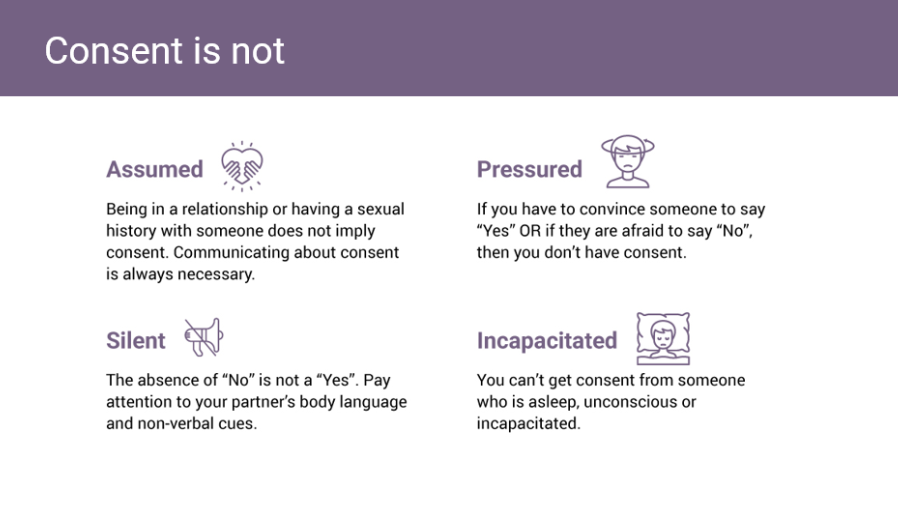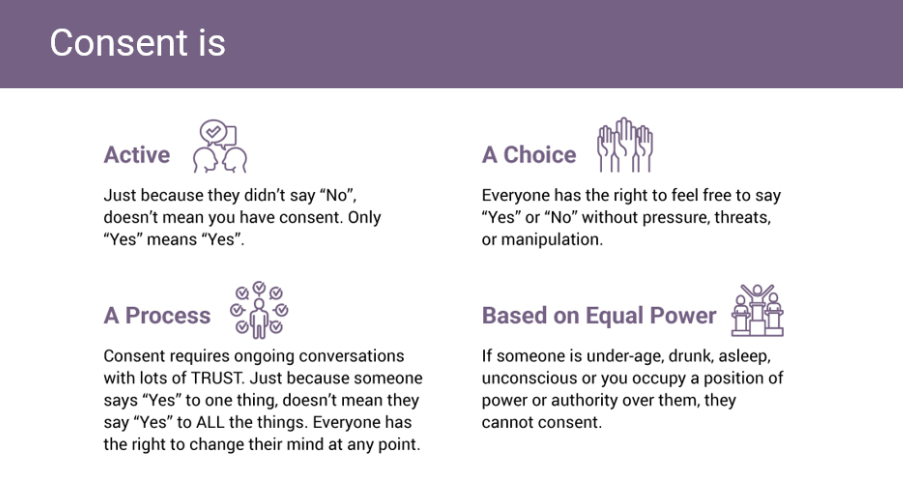What is consent?
Consent is an agreement to engage in an activity; it occurs when you ask, or give, permission to do something. People use consent in their daily life, including giving and asking for consent for food or drink, physical touch, to take a picture, or to participate in an activity. In the context of sexual activities, consent refers to giving voluntary permission to engage in a sexual activity. Consent1:
- Is a freely given enthusiastic yes
- Is ongoing, continuously discussed
- Can be taken away at any time
Consent must be asked for and given at each stage of a sexual interaction and/or when there is a shift from one sexual activity to another (e.g., persons move from hugging to – {get/give consent} – kissing). Consent must be given voluntarily. Even if a person has consented to sexual activity in the past, consent must be asked for each time. There is no voluntary consent when:
- You are asked repeatedly until you give someone the answer they want to hear.
- Someone uses their power or authority to manipulate your answer.
- When you are intoxicated or incapacitated.

If you are interested in learning more about consent, please view the following videos:
- Tea Consent (Clean) - YouTube
- Consent – YouTube
- Let’s Talk About Consent – YouTube
- Consent: Have the Conversation – YouTube
What is sexualized violence?
Sexualized violence is any act of a sexual nature that occurs without your consent2. It includes any sexual act or act that targets your sexuality, your gender identity or gender expression. Sexualized violence can range from unwanted sexual comments to assault.
- Sexualized violence can be physical or psychological.
- It can be threatened, attempted, or committed.
- It can be an ongoing situation or a one-time event.
- It can be something that happens in-person or online.
- It can happen between strangers, between students or co-workers, or between people in a relationship.
Sexual Assault
- Please visit this webpage to learn more about sexual assault.
Sexual Harassment
Sexual harassment refers to unwanted or unwelcome behaviour of a sexual nature. Sexual harassment may include, but is not limited to3:
- Requests for sexual favours
- Unwanted or unwelcome physical contact
- Unwelcome sexual flirtations, advances, or propositions
- Sexually suggestive, obscene, or degrading comments or gestures
- Offensive jokes or remarks of a sexual nature
- Leering or staring
- Displaying, circulating or sharing pictures or other materials of a sexual nature that are not within legitimate or appropriate academic or work-related norms
- Unwelcome questions or remarks about a person’s sex life, gender appearance, clothing, and/or sexual orientation
- Expressed or implied promise of reward in return for complying with a sexual request.
Sexual harassment may interfere with a person’s ability to participate in employment, school, or daily life; it may create an intimidating, humiliating or hostile environment.
Sexualized Violence Online
Any form of sexualized violence that occurs online is considered technological-facilitated sexualized violence. Technology-facilitated sexualized violence (TFSV) “refers to a wide range of unacceptable, violent, and abusive behaviours, where technology is used as a central tool to carry out these behaviours”4. These behaviours can include online sexual harassment, online threats of sexual violence, trolling, non-consensual distribution of intimate images, and many other harmful behaviours that occur online and/or are facilitated through the use of technology.
For an overview of TFSV please watch this video.
For more information on TFSV, the different types of violence that occur and the harms they cause, and resources that can help, please see below.
Technology-Facilitated Gender-Based Violence: An Overview – report from the Centre from International Governance Innovation that provides an overview of the different forms of technology-facilitated gender-based violence and the harms they cause.
Unacceptable: Responding to Technology-Facilitated Gender-Based Violence – report from the Women’s Legal Education and Action Fund that includes information on what you can do, and the support resources you can access if you’re experiencing TFGBV.
BC Society of Transition Houses (BCSTH) Technology Safety Project – provides resources and toolkits to increase and preserve safety and privacy online.
- This definition of consent is adapted from the Consent and Sexual Violence Training and Facilitation Guide: Preventing and Responding to Sexual Violence in BC Post-Secondary Institutions (2021), Sexual Violence Training Development Team. Consent & Sexual Violence: Training and Facilitation Guide – Simple Book Publishing (opentextbc.ca)
- Sexual Violence Training Development Team. (2021). Safer Campuses for Everyone: Implementation Guide. https://opentextbc.ca/safercampuses
- Please see Kwantlen Polytechnic University’s Sexual Violence and Misconduct Policy (2019) and Capilano University's Sexual Violence Policy (2021).
- Kim, Rosel. 2021. Unacceptable: Responding to Technology-Facilitated Gender-Based Violence. Women’s Legal Education and Action Fund (LEAF). Unacceptable-Responding-to-TFGBV.pdf (leaf.ca)
- Consent and Sexual Violence Training and Facilitation Guide: Preventing and Responding to Sexual Violence in BC Post-Secondary Institutions Consent & Sexual Violence: Training and Facilitation Guide – Simple Book Publishing (opentextbc.ca) Repairing Harm. Graphic adapted from resource, April 2020, Thompson Rivers University

